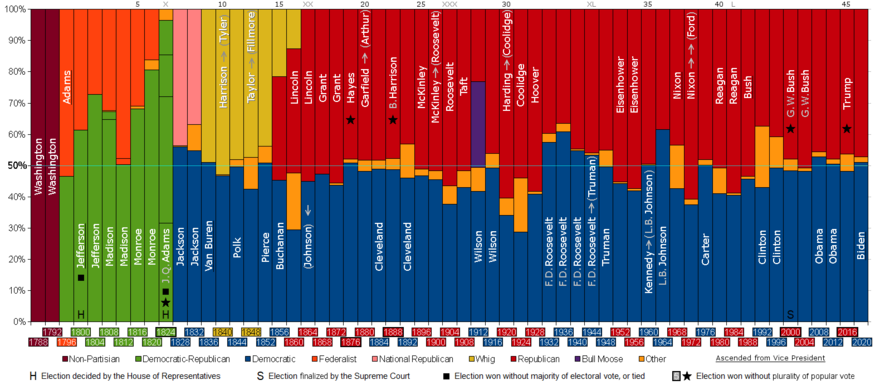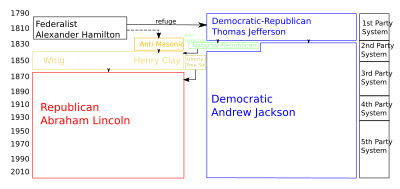Political parties in the United States facts for kids
In the United States, politics has almost always been a contest between two major political parties. This has been true since the country was very young. For over 150 years, since the 1850s, these two main parties have been the Democratic Party and the Republican Party.
Together, the Democrats and Republicans have won every presidential election since 1852. They have also controlled the United States Congress since 1856. Even though their names have stayed the same, what each party believes in has changed a lot over time. Today, the Democratic Party is generally considered left-of-center, while the Republican Party is considered right-of-center.
The U.S. Constitution doesn't actually mention political parties. The two-party system developed over time through laws and tradition. There are also smaller parties, called third parties, like the Libertarian, Green, and Constitution parties. Sometimes, they get people elected to local offices.
Many voters, about 35-45%, don't belong to any party and call themselves independents. However, most independents tend to vote for one of the two major parties. In Congress, independent members usually work with either the Democrats or Republicans to pass laws.
Contents
- History of U.S. Political Parties
- The Founding Fathers' Views on Parties
- How the Parties Changed Over Time
- First Party System: 1792–1824
- Second Party System: 1828–1854
- Third Party System: 1854–1890s
- Fourth Party System: 1896–1932
- Fifth Party System: 1932–1976
- Sixth Party System: 1980–2016
- A Possible Seventh Party System: 2016–Present
- How American Parties Are Organized
- Major Parties Today
- Minor Parties and Independents
- See also
History of U.S. Political Parties
Political scientists have divided the history of America's two-party system into different periods called "party systems." Each system had its own unique set of major parties and issues.
The Founding Fathers' Views on Parties
The Founding Fathers, who wrote the Constitution, did not want political parties. In writings like the Federalist Papers, leaders like James Madison and Alexander Hamilton warned about the dangers of political groups.
George Washington, the first president, was not a member of any party. In his famous Farewell Address, he warned that parties could cause conflict and stop the government from working properly. However, parties formed very soon after the government began.
How the Parties Changed Over Time
The two major parties have changed a lot since they were created. After the Civil War, the Democratic party was mostly made up of southern farmers and city workers. The Republican party was supported by business owners, professionals, and freed African Americans in the industrial northeast.
By the 21st century, this had flipped. The Democratic party became a home for women, union members, and people living in cities. The Republican party's supporters were more likely to be from rural areas, southern states, and religious groups. This shift also led to more disagreement between the parties.
First Party System: 1792–1824
The first American parties grew out of President Washington's group of advisors.
- The Federalists, led by Alexander Hamilton, wanted a strong central government to support business and industry.
- The Democratic-Republicans, led by Thomas Jefferson and James Madison, wanted a weaker central government and more power for farmers and states.
The Democratic-Republicans became the main party after 1800. The Federalist Party faded away after the War of 1812. This led to a short time with very little party conflict, known as the Era of Good Feelings.
Second Party System: 1828–1854
By the 1820s, the old Democratic-Republican party had split.
- The Democratic Party formed around President Andrew Jackson. They supported individual and state rights and were popular with the "common man."
- The Whig Party, led by Henry Clay, opposed Jackson. They wanted Congress to be more powerful than the president and supported modernizing the economy.
The main issue that broke this system apart was slavery. The Whig Party tried to find a middle ground but failed. It collapsed in the 1850s, and the anti-slavery Republican Party was born.
| Party System | Party A | Party B |
|---|---|---|
| First | 7 | 1 |
| Second | 5 | 2 |
| Third | 3 | 7 |
| Fourth | 2 | 7 |
| Fifth | 7 | 2 |
| Sixth | 6 | 8 |
Third Party System: 1854–1890s
This system was a battle between the new Republican Party and the older Democratic Party.
- The Republican Party was against the spread of slavery. After the Civil War, it became the most powerful party for many years. Its supporters included business owners, professionals, and African Americans. It was often called the "Grand Old Party" (GOP).
- The Democratic Party was usually the opposition. It was strong in the South, where it supported states' rights. It also had support from small farmers in the West and immigrants in northern cities.
During this time, being loyal to a party was very important. Party events, like parades, were a big part of social life in many towns.
Fourth Party System: 1896–1932
The Republican Party remained dominant during this period, known as the Progressive Era. The main political debates changed. People were now concerned with the power of big corporations, working conditions, and making government more honest and efficient. Issues like women's suffrage (the right to vote) also became important.
Fifth Party System: 1932–1976
The Great Depression caused a major shift in politics. President Franklin D. Roosevelt, a Democrat, created the New Deal. These programs greatly expanded the role of the federal government.
- The Democratic Party became the party of "big government." It built a powerful coalition of city dwellers, labor unions, small farmers, and African Americans. This group kept the Democrats in power for decades.
- The Republican Party was now the more conservative party, often opposing the New Deal programs.
During the 1960s, the Democratic Party's support for civil rights laws caused many white voters in the South to switch to the Republican Party. This was a major change that reshaped American politics.
Sixth Party System: 1980–2016
By the 1980s, the parties had become more divided by their beliefs.
- The Republican Party, led by figures like President Ronald Reagan, focused on tax cuts, a strong military, and conservative social values. Its base included business owners, rural voters, and religious conservatives.
- The Democratic Party was increasingly made up of African Americans, Latinos, and white city-dwellers with progressive views. College-educated voters, who once favored Republicans, began to support the Democrats more.
A Possible Seventh Party System: 2016–Present
Some experts believe a new party system began around 2016 with the election of Donald Trump.
- The Republican Party began to focus more on cultural issues and less on free trade. It became more populist, meaning it appealed directly to ordinary people who felt ignored by traditional leaders.
- The Democratic Party continued to be a coalition of different groups, with a strong base among educated and urban voters.
How American Parties Are Organized
American political parties are not as strict as parties in other countries. The Democratic and Republican parties don't have official membership lists that they control. In most states, anyone can register with a party to vote in its primary election. A primary is an election to choose the party's candidate for the main election.
This means party leaders can't stop someone from running as a member of their party, even if that person disagrees with the party's main ideas. Once in office, politicians can sometimes vote against their own party without much punishment.
Each party has a national committee (the Democratic National Committee and Republican National Committee). These committees raise money and help run campaigns, especially for president. There are also party organizations in every state.
Major Parties Today
| American voter registration statistics as of October 2020 |
|||
|---|---|---|---|
| Party | Registered voters | Percentage | |
| Democratic | 45,512,696 | 38.62 | |
| Republican | 37,314,494 | 30.44 | |
| No party preference | 34,798,906 | 28.39 | |
| Other | 3,127,800 | 2.55 | |
| Totals | 122,577,294 | 100.00 | |
Democratic Party
The Democratic Party is the world's oldest political party that is based on voter support. Since the 1930s, it has generally supported a more active role for the government in society. Democrats often support programs for social justice, a mixed economy, and a strong social safety net.
Today, Democrats are strongest on the East and West Coasts and in large cities. Their supporters include many African Americans, Latinos, and members of trade unions. In 2018, the Democratic Party was the largest in the U.S. by registered members.
Republican Party
The Republican Party, also known as the GOP (Grand Old Party), was founded in 1854 by activists who opposed slavery. For much of the 20th century, the party supported business interests, lower taxes, and a strong national defense.
Today, the Republican Party is strongest in the South and in rural areas. Its platform is generally based on American conservative ideas. These include fiscal conservatism (careful government spending) and social conservatism (traditional values). In recent years, the party has also adopted more populist and nationalist positions.
Minor Parties and Independents
While the two major parties dominate, smaller "third parties" also play a role. They rarely win national elections, but they can bring important issues to public attention.
- Libertarian Party: This is the largest third party. Libertarians want to greatly reduce the size and power of government. They support free markets and strong personal freedoms.
- Green Party: The Green Party focuses on environmental issues, social justice, and nonviolence. It is considered a left-wing party.
- Constitution Party: This is a conservative party that wants the government to follow the U.S. Constitution very strictly.
Some politicians and voters are independents, meaning they don't belong to any party. As of July 2025, two U.S. Senators, Angus King and Bernie Sanders, are independents. Both usually work with the Democrats.
See also
- Political history in the United States, for historiography
- Red states and blue states



